Related Research Articles

Pisa is a city and comune in Tuscany, central Italy, straddling the Arno just before it empties into the Ligurian Sea. It is the capital city of the Province of Pisa. Although Pisa is known worldwide for its leaning tower, the city contains more than twenty other historic churches, several medieval palaces, and bridges across the Arno. Much of the city's architecture was financed from its history as one of the Italian maritime republics.
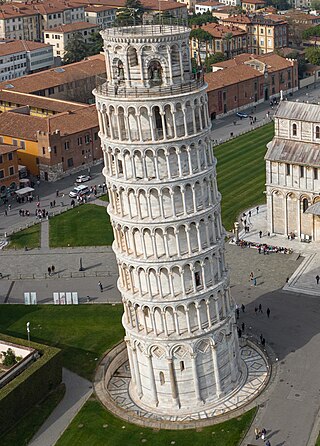
The Leaning Tower of Pisa, or simply the Tower of Pisa, is the campanile, or freestanding bell tower, of Pisa Cathedral. It is known for its nearly four-degree lean, the result of an unstable foundation. The tower is one of three structures in the Pisa's Cathedral Square, which includes the cathedral and Pisa Baptistry.
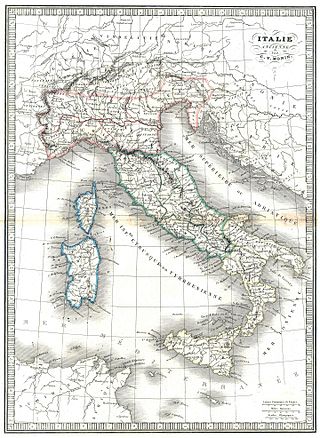
The European country of Italy has been inhabited by humans since at least 850,000 years ago. Since classical antiquity, ancient Etruscans, various Italic peoples, Celts, Magna Graecia colonists, and other ancient peoples have inhabited the Italian Peninsula.

The Republic of Pisa was an independent state existing from the 11th to the 15th century and centered on the Tuscan city of Pisa. It rose to become an economic powerhouse, a commercial center whose merchants dominated Mediterranean and Italian trade for a century, before being surpassed and superseded by the Republic of Genoa.

Vittorio Valletta was an Italian industrialist and president of Fiat S.p.A. from 1946 to 1966.

The maritime republics, also called merchant republics, were Italian thalassocratic port cities which, starting from the Middle Ages, enjoyed political autonomy and economic prosperity brought about by their maritime activities. The term, coined during the 19th century, generally refers to four Italian cities, whose coats of arms have been shown since 1947 on the flags of the Italian Navy and the Italian Merchant Navy: Amalfi, Genoa, Pisa, and Venice. In addition to the four best known cities, Ancona, Gaeta, Noli, and, in Dalmatia, Ragusa, are also considered maritime republics; in certain historical periods, they had no secondary importance compared to some of the better known cities.

Luchino Visconti (also spelled Lucchino, 1287 or 1292 – January 24, 1349) was lord of Milan from 1339 to 1349. He was also a condottiero, and lord of Pavia.
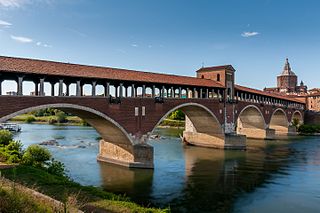
The Ponte Coperto or the Ponte Vecchio is a stone and brick arch bridge over the river Ticino in Pavia, Italy.

Domenico Losurdo was an Italian historian, essayist, Marxist philosopher, and communist politician.

Alessandro Barbero is an Italian historian, novelist and essayist.
Oberto D'Oria was an Italian politician and admiral of the Republic of Genoa, ruling the republic as Capitano del popolo.
Paolo Malanima is an Italian economic historian, Professor Emeritus of Economic History at the Magna Graecia University of Catanzaro, and former director of the Institute of Studies on Mediterranean Societies in Naples. Malanima's main research interests are long-term developments in economic history, particularly the performance of the Italian economy since Classical antiquity, history of energy and global history.

The Genoesecolonies were a series of economic and trade posts in the Mediterranean and Black Seas. Some of them had been established directly under the patronage of the republican authorities to support the economy of the local merchants, while others originated as feudal possessions of Genoese nobles, or had been founded by powerful private institutions, such as the Bank of Saint George.
Attilio Celant, 2nd Class / Grand Officer of the Order of Merit of the Italian Republic, is an Italian economist, geographer and academic.
Federico Cafiero was an Italian mathematician known for his contributions in real analysis, measure and integration theory, and in the theory of ordinary differential equations. In particular, generalizing the Vitali convergence theorem, the Fichera convergence theorem and previous results of Vladimir Mikhailovich Dubrovskii, he proved a necessary and sufficient condition for the passage to the limit under the sign of integral: this result is, in some sense, definitive. In the field of ordinary differential equations, he studied existence and uniqueness problems under very general hypotheses for the left member of the given first order equation, developing an important approximation method and proving a fundamental uniqueness theorem.
Paul Anthony Ginsborg was a British historian. In the 1980s, he was Professor at the University of Siena; from 1992, he was Professor of Contemporary European History at the University of Florence.
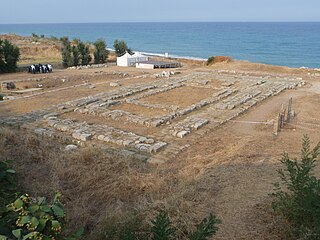
Caulonia or Caulon was an ancient city on the shore of the Ionian Sea near Monasterace, Italy.

Alessandro Agostinelli is an Italian writer, journalist and poet. Alessandro Agostinelli is an Italian writer, journalist and poet.
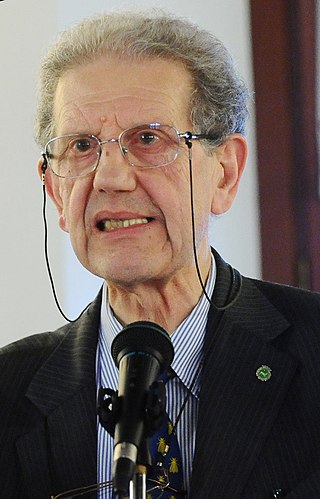
Salvatore Settis is an Italian archaeologist and art historian. From 1994 to 1999 he was director of the Getty Center for the History of Art and the Humanities in Los Angeles and from 1999 to 2010 of the Scuola Normale Superiore in Pisa.

The Arianese dialect, typical of the territorial area of Ariano Irpino, is a vernacular variety of the Irpinian dialect, belonging in turn to the Neapolitan group of southern Italian dialects. Like all Romance languages, it descends directly from Vulgar Latin, a language of Indo-European stock that has been widespread in the area since Roman times.
References
- ↑ Núñez, Clara Eugenia (1998). Insurance in Industrial Societies: Economic Role, Agents and Market from 18th Century to Today. Universidad de Sevilla. p. 13. ISBN 978-84-472-0445-8 . Retrieved 20 June 2012.
- ↑ Barbarisi, Gennaro (2000). L'amabil rito: società e cultura nella Milano di Parini. Cisalpino. ISBN 978-88-323-4588-9 . Retrieved 20 June 2012.
- ↑ Società storica pisana (2006). Bollettino storico pisano. Pacini Editore. p. 389. Retrieved 20 June 2012.
- ↑ Zorattini, Pier Cesare Ioly (2005). Percorsi di storia ebraica. Atti del Convegno internazionale (Cividale del Friuli-Gorizia, 7-9 settembre 2004). Forum. p. 58. ISBN 9788884202581 . Retrieved 20 June 2012.
- ↑ Alimento, A. (2012). War, Trade and Neutrality. Europe and the Mediterranean in Seventeenth and Eighteenth Centuries. FrancoAngeli. p. 16. ISBN 978-88-568-4514-3 . Retrieved 20 June 2012.